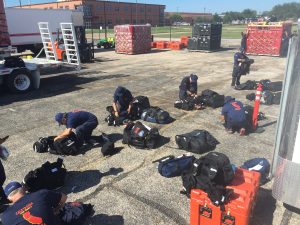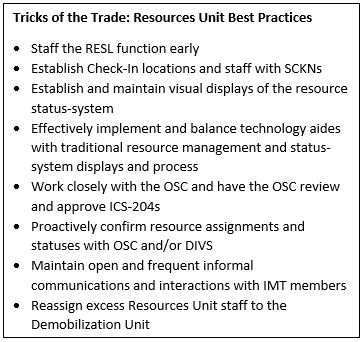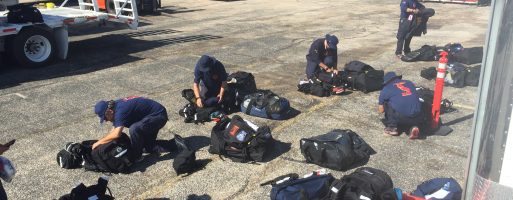EMSI will participate in the Clean Gulf Conference October 29-30 in New Orleans, LA and Vice President of Operations Billy Haley will speak about the Critical Role of the Resources Unit Leader as part of session 6G: Training and Developing Key IMT Members.
IMT success is dependent upon not only staffing essential functions on the team, but who is filling those key positions and how effectively they execute their responsibilities. Absolutely critical to the success of the IMT is a qualified Resources Unit Leader (RESL) to manage a high-functioning Resources Unit.
Role and Importance of the Resources Unit

Responsible for maintaining the status of all assigned tactical resources and personnel at the incident, the RESL oversees the check-in of all tactical resources and personnel and maintains a resource status-keeping system indicating the current assignment and status of all resources. In addition, the RESL is also responsible for maintaining a Resource Status Display. As part of this display, the RESL determines how to best present the information to the IMT members. Typically, such a display would include a poster size ICS-201 and a T-card rack (magnet, dry erase boards, computerized). A benefit of this visual display is that the t-card racks can more easily aid the RESL in identifying span of control issues and discuss options to mitigate such issues (e.g., use of Strike Teams, Task Forces). This detailed oversight ensures that all employed assets are most efficiently and effectively used during a response where time can be critical to saving lives, the environment, and infrastructure.
Beyond that, the RESL plays a critical role in the development of the Incident Action Plan (IAP) and the overall incident resource management process. An IAP is essential to affecting successful outcomes in any response, particularly emergency operations, in a timely manner. As a key part of the IAP development process, it is the Resources Unit that makes the specific resource assignments, right down to the exact resources assigned to a Division, Group, or Staging Area, to satisfy the resource requirements identified by the Operations Section Chief (OSC) on the Operational Planning Worksheet, ICS-215. From the developed ICS-215 worksheet, an Assignment List, ICS-204, is developed to further designate specific work assignments to be taken within a Division or Group, providing task direction for individual components of the Division/Group. As part of the incident resource management process, the Resources Unit identifies all resource shortfalls and works with the Supply Unit (SPUL) in the Logistics Section to generate resource requests and orders using the Resource Request Message (ICS-213-RR), and by designating specific resources for tactical work assignments, the Finance Section knows which resources are being used and need to be paid.
Without a qualified RESL and a functioning Resources Unit:
- Specific tactical resource assignments might never make it into the IAP, and the IAP would be less effective.
- Resource shortfalls might never be identified, resulting in either perpetual resource shortfalls or inefficient resource management.
- We don’t know which resources are being utilized in any given Operational Period, creating complications for cost accounting.
Resources Unit Staffing
There are two primary ICS positions that the RESL relies upon: Assistant RESLs and Status/Check-In Recorders (SCKNs). An Assistant RESL(s) can assume some of the management and process responsibility of the RESL, as delegated by the RESL. SCKNs are invaluable in establishing and staffing check-in locations, managing the check-in process, establishing and maintaining resource status-keeping systems, confirming resource statuses and assignments with the OSC, supporting IAP development, and identifying when there are resource shortfalls or excesses. Where possible, it is recommended to use Demobilization Unit personnel to staff SCKNs to ensure all appropriate information is collected at check-in and subsequently available as demobilization plans are developed.
RESL Relationship with the OSC and IAP Development
The RESL maintains a close relationship with the OSC as the RESL is responsible for tracking and maintaining status of all resources assigned to the Operations Section. Forged during the initial response when the RESL arrives and assists the OSC with the check-in and tracking of tactical resources, this relationship evolves as the response shifts from reactive to proactive, or managed. As the OSC identifies resource requirements on the ICS-215, the RESL completes the “Have” and “Need” rows, effectively identifying the resource shortfalls required to execute the OSC’s intended plan. During the actual preparation of the IAP, the RESL uses the generic resource requirements (kind, type, etc.) identified by the OSC on the ICS-215 to make tactical work assignments for specific resources, developing the Assignment Lists, ICS-204s, for each Division, Group, and Staging Area. Finally, the RESL assists the OSC with the tracking of tactical resources during the Operational Period, including recording any changes in resource status or assignment made by the OSC. One could argue that the RESL maintains a closer relationship with the OSC than the RESL does with the PSC, highlighting the importance of informal communication outside of the formal chain-of-command.
Preparing the RESL for Success
Absent the human factors required of a RESL, most notably a keen attention to detail and general process management acumen, there are several steps we can take to ensure that the RESL is prepared to effectively perform as a member of an IMT.
Training: RESL training begins with “system” or “core” training through the ICS-300 level where they will learn about the IMT organization, the principles of incident resource management, and the IAP planning process. Next, a prospective RESL should advance to RESL position-specific training. This may consist of a formal RESL training course such as ICS-348 or FEMA L965, or more informally through various RESL workshops that collectively cover the objectives of a formal RESL training course. Finally, given the significant degree of interactivity the RESL has with their fellow IMT members, a RESL should complete formal IMT training, such as an ICS-320 course, to explore and practice their interactions with the rest of the IMT and involvement in IAP development and incident resource management. Training a team to function as a unit is critical to their success during an incident.
Exercises: ICS qualification and proficiency are reliant on practical application. Absent considerable real-world response, a RESL will gain proficiency through drills and exercises where they can perform the RESL function in a simulated environment. To ensure a valuable learning environment for the RESL, exercise planners must ensure the exercise is designed to include a thorough resource management process, IAP development, and robust IMT participation. For full-scale exercises with real tactical resources, the RESL must work with the OSC to check-in, assign, and track resources while assisting with the IAP development. During smaller-scale or “Command Post” exercises with simulated tactical resources, exercise planners must develop a notional resource list giving the RESL simulated resources to track, and possibly establish a Sim-Cell to create an interactive platform for the RESL and other exercise participants.

Qualification: ICS is a performance-based qualification system. An effective RESL has likely completed a performance-based qualification process using a position-task book (PTB) or “Qual Book”, with a qualified RESL evaluating the performance of the Trainee and signing off on completed tasks.
Proficiency: If the RESL seldom uses their RESL skills, the skills will atrophy. The RESL must participate in real-world incidents, simulated drills and exercises, and other interactive professional development means to maintain proficiency of the RESL skills. Lacking these opportunities, it is incumbent on the RESL to frequently review course materials, policies and procedures, and job aids that may relate to their assignment on an IMT.
Performance Support: The RESL can be supported with various performance support tools such as a RESL specific job aid or incident coaching and mentoring. Although many performance support tools may be available electronically, such technology may not be available in the early stages of an incident.
Technology: Technology, such as resource tracking and IAP automation software, can be a valuable tool for enhancing the performance and efficiency of the Resources Unit, but the RESL and IMT cannot be over-reliant on a technology crutch. The RESL should use technology to aid, not replace knowledge, in the execution of the RESL function. Depending on the incident and its magnitude, technology such as cell service or even electricity may not be available upon first arriving on site. An effective RESL must first understand the incident resource management process (resource check-in, status-keeping, IAP development, etc.); then they can use technology to support and augment their performance. Think about it this way: we still teach children basic arithmetic and require them to demonstrate proficiency before graduating to a calculator; we must also teach the RESL, and they must demonstrate mastery of, the long-form resource management process before giving them the option to implement a technological aid.
RESL and Safety
One final thought. Almost universally Command’s number one priority is the safety of responders. How does an IMT ensure the safety of their responders? It starts with RESL and resource check-in, tracking, and responder accountability. You can’t keep them safe if you don’t know where they are.


